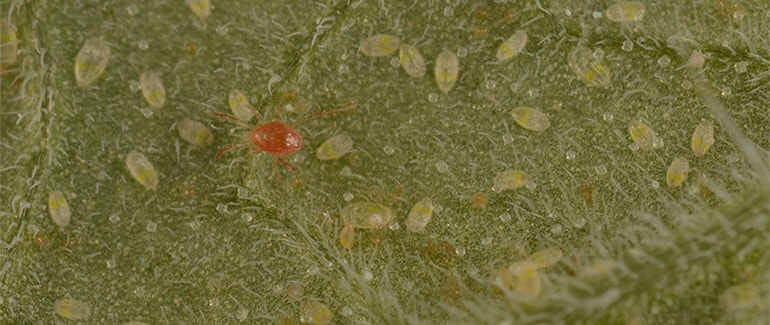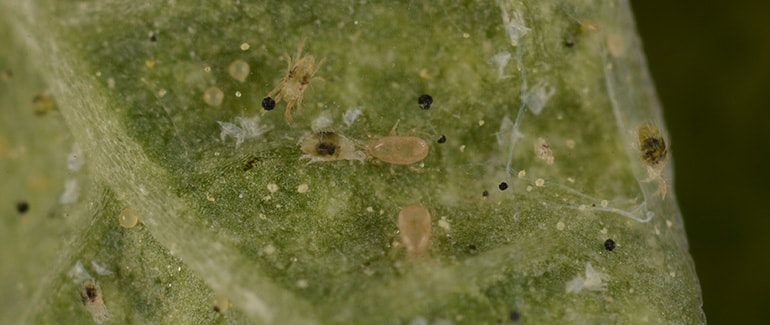In order to control agricultural pests, sometimes growers need to turn to natural solutions to help increase the efficiency of an existing integrated pest management program, or in the case of organic growers, to meet regulatory standards. One of the most heavily utilized natural solutions to control these pests is the use of biocontrol agents. Biocontrol agents are any living organism that can be used to control a pest organism. Relevant examples in agriculture include predatory insects, mites, and nematodes, as well as microorganisms, such as fungi and bacteria. All of these organisms can be used as both preventative and curative means of control and can oftentimes be integrated directly into existing control programs through careful coordination of pesticide applications. While many of these control agents have been in production for the past couple of decades, one of the main barriers of adoption has been the need to adequately train growers on what considerations to make in order to ensure successful application, monitoring, and management of these beneficial organisms. Much like pesticides, there are optimum environmental conditions for each biocontrol agent, and these conditions can be absolutely critical to the success of their use. Considerations like appropriate temperature, relative humidity, and intensity of sunlight, can greatly augment the efficacy of nearly all commercially implemented species. While a number of the microbial biocontrol agents, such as Beauveria bassiana and Bacillus thuringiensis, have commercial application labels that advise end users with application instructions and considerations, many of the macroscale biological control agents (predatory insects and mites), do not have such labels and rely on effective grower training from biocontrol companies and/or consultants. If these entities do not accurately convey relevant application and management information, the success of biocontrol agents can be drastically reduced. Here we will outline some of the main considerations to be made while using two of the most commonly used predatory mites for twospotted spider mite, Tetranychus urticae, control in Florida strawberries.
Phytoseiulus persimilis

- Optimum Temperature: 68-86°F
- Optimum Relative Humidity: 70-80% inside plant canopy
- Life span: 30-36 days
- Pests addressed: twospotted spider mite
- Spray considerations: Can be adversely affected by many pesticides. Growers should consult side effects manuals for full spray program
- Use: Curative control of spider mites
Neoseiulus californicus

- Optimum Temperature: 50-91°F
- Optimum Relative Humidity: 40-80% inside plant canopy
- Life Span: 24-32 days
- Pests addressed: Various spider mites and microscopic mites (broad, cyclamen, and russet mites), thrips and other small insect pests (cause lower reproduction rates). Can also subsist on pollen for short periods of time
- Spray considerations: Tolerant of certain miticides such as bifenazate (acramite), but grower should consult side effects manuals for full spray program
- Use: Preventative control of spider mites
If the above conditions and considerations are accounted for in a grower’s integrated pest management program, it is possible to see control of twospotted spider mite that is just as, if not more effective, than traditional miticide-only programs. If utilized correctly, biocontrol programs implemented alongside other management strategies can help keep pest populations down below economic thresholds, preventing economic injury.
References:
Kim, T., J. Ahn, and J.-H. Lee. 2009. Temperature-dependent developmental model ofNeoseiulus californicus(McGregor) (Acari, Phytoseiidae). Journal of Applied Entomology. 133: 284–291.
Rhodes, E. M., and O. E. Liburd. 2005. Predatory Mite, Neoseiulus californicus (McGregor) (Arachnida: Acari: Phytoseiidae). IFAS EDIS. https://edis.ifas.ufl.edu/in639
Stenseth, C.1979. Effect of temperature and humidity on the development ofPhytoseiulus Persimilis and its ability to regulate populations ofTetranychus urticae [Acarina: Phytoseiidae. Tetranychidae]. Entomophaga. 24: 311–317.

Chris Crockett is the staff entomologist and Director of Research and Grower Services at Highland Precision Agriculture, where he focuses on managing field operations and providing recommendations for various integrated pest management programs. He is currently completing his PhD in Entomology at the University of Florida, expected to graduate in 2019. Chris has worked on farms all over the world, including Florida, Virginia, Ireland, and Finland where he has focused on observing and implementing sustainable pest management systems in a diversity of crops.